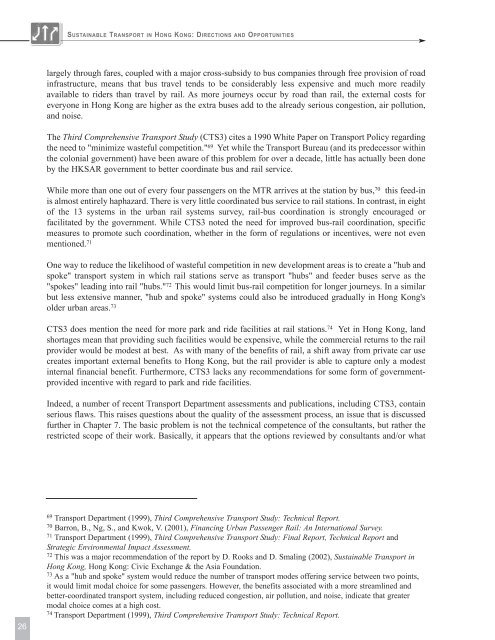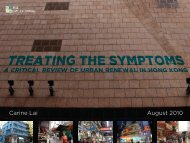Untitled - Civic Exchange
Untitled - Civic Exchange
Untitled - Civic Exchange
You also want an ePaper? Increase the reach of your titles
YUMPU automatically turns print PDFs into web optimized ePapers that Google loves.
SUSTAINABLE TRANSPORT IN HONG KONG: DIRECTIONS AND OPPORTUNITIES<br />
largely through fares, coupled with a major cross-subsidy to bus companies through free provision of road<br />
infrastructure, means that bus travel tends to be considerably less expensive and much more readily<br />
available to riders than travel by rail. As more journeys occur by road than rail, the external costs for<br />
everyone in Hong Kong are higher as the extra buses add to the already serious congestion, air pollution,<br />
and noise.<br />
The Third Comprehensive Transport Study (CTS3) cites a 1990 White Paper on Transport Policy regarding<br />
the need to "minimize wasteful competition." 69 Yet while the Transport Bureau (and its predecessor within<br />
the colonial government) have been aware of this problem for over a decade, little has actually been done<br />
by the HKSAR government to better coordinate bus and rail service.<br />
While more than one out of every four passengers on the MTR arrives at the station by bus, 70 this feed-in<br />
is almost entirely haphazard. There is very little coordinated bus service to rail stations. In contrast, in eight<br />
of the 13 systems in the urban rail systems survey, rail-bus coordination is strongly encouraged or<br />
facilitated by the government. While CTS3 noted the need for improved bus-rail coordination, specific<br />
measures to promote such coordination, whether in the form of regulations or incentives, were not even<br />
mentioned. 71<br />
One way to reduce the likelihood of wasteful competition in new development areas is to create a "hub and<br />
spoke" transport system in which rail stations serve as transport "hubs" and feeder buses serve as the<br />
"spokes" leading into rail "hubs." 72 This would limit bus-rail competition for longer journeys. In a similar<br />
but less extensive manner, "hub and spoke" systems could also be introduced gradually in Hong Kong's<br />
older urban areas. 73<br />
CTS3 does mention the need for more park and ride facilities at rail stations. 74 Yet in Hong Kong, land<br />
shortages mean that providing such facilities would be expensive, while the commercial returns to the rail<br />
provider would be modest at best. As with many of the benefits of rail, a shift away from private car use<br />
creates important external benefits to Hong Kong, but the rail provider is able to capture only a modest<br />
internal financial benefit. Furthermore, CTS3 lacks any recommendations for some form of governmentprovided<br />
incentive with regard to park and ride facilities.<br />
Indeed, a number of recent Transport Department assessments and publications, including CTS3, contain<br />
serious flaws. This raises questions about the quality of the assessment process, an issue that is discussed<br />
further in Chapter 7. The basic problem is not the technical competence of the consultants, but rather the<br />
restricted scope of their work. Basically, it appears that the options reviewed by consultants and/or what<br />
26<br />
69 Transport Department (1999), Third Comprehensive Transport Study: Technical Report.<br />
70 Barron, B., Ng, S., and Kwok, V. (2001), Financing Urban Passenger Rail: An International Survey.<br />
71 Transport Department (1999), Third Comprehensive Transport Study: Final Report, Technical Report and<br />
Strategic Environmental Impact Assessment.<br />
72 This was a major recommendation of the report by D. Rooks and D. Smaling (2002), Sustainable Transport in<br />
Hong Kong, Hong Kong: <strong>Civic</strong> <strong>Exchange</strong> & the Asia Foundation.<br />
73 As a "hub and spoke" system would reduce the number of transport modes offering service between two points,<br />
it would limit modal choice for some passengers. However, the benefits associated with a more streamlined and<br />
better-coordinated transport system, including reduced congestion, air pollution, and noise, indicate that greater<br />
modal choice comes at a high cost.<br />
74<br />
Transport Department (1999), Third Comprehensive Transport Study: Technical Report.

















